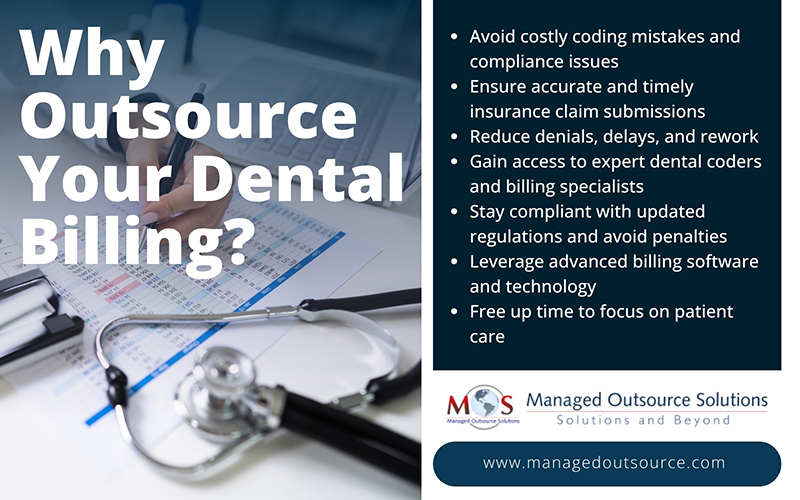Coding is a key step in dental revenue cycle management (RCM) and the basis for efficient dental billing. Even minor dental coding errors can lead to claim denials, revenue loss, or audits. Common mistakes range from wrong CDT code selection and unbundling to insufficient documentation of medical necessity and ignoring changes to code updates. In fact, most practices turn to dental RCM services to avoid mistakes and implement best practices for error-free dental billing and coding.
With CDT codes updated annually and payer rules constantly evolving, it’s crucial for dental practices to stay vigilant. Here are the common dental coding errors and how providers can avoid them to ensure smoother claims processing.
Avoiding Claim Denials: Common Dental Coding Issues Every Practice Should Know
Here are five prevalent coding errors dental practices must watch out for:
- Using the wrong dental code: Using a CDT (Current Dental Terminology) code that does not accurately reflect the performed procedure is a frequent error. For example, these are different types of radiographs and poor understanding of these procedures can lead to wrong code assignment. Confusion about panoramic x-rays can lead to billing D0210 (Intraoral – Complete Series) instead of D0330 (Panoramic Radiographic Image).
- Upcoding and Downcoding: Reporting codes that overstate (upcoding) or understate (downcoding) services is another common mistake.Upcoding can result in billing for a more complex or expensive procedure than the one actually provided, which is considered a form of fraud. For e.g., if a patient receives a routine dental cleaning, it should be billed using D1110 (Prophylaxis – Adult). Instead, if the dentist bills D4346 (scaling in presence of generalized moderate or severe gingival inflammation), this is an upcoding mistake. D4346 is a more complex and higher-paying procedure and billing this code for a simple cleaning is considered upcoding, which can lead to audits, repayment demands, fines, or even legal action for fraud.Downcoding or undercoding refers to using a code that does not accurately reflect the provided service, for e.g., reporting D0140 (Limited Problem-Focused Exam) for a new patient instead of D0150 (Comprehensive Oral Evaluation). Using the wrong code (D0140) leads to misreporting the comprehensive evaluation which provides a full picture of the patient’s oral health, and can mean lower reimbursement.
- Unbundling: This refers to billing two or more CDT codes separately when they should be included in one inclusive code. For example, for a tooth extraction procedure, the correct billing code is D7140 (Extraction, erupted tooth or exposed root – includes local anesthesia and suturing if needed). Local anesthesia and suturing are standard parts of a tooth extraction.If the provider separately bills D9215 (local anesthesia) and D7910 (suture of small wounds) instead of using the single comprehensive code D7140, it is an unbundling mistake.
- Not keeping up to date with changes to CDT codes: The American Dental Association updates CDT codes annually. For e.g., the changes to the CDT code set for 2025 includes 10 new codes, 8 revised codes, and 2 deleted codes, totaling 20 changes. Failing to keep up with these yearly changes can lead to using outdated codes and claim denials.
- Insufficient documentation: Failing to provide clear and detailed documentation to support the medical necessity of a procedure can lead to denied claims. Not including necessary documentation, such as X-rays, periodontal charting, or clinical notes, can result in claim rejections—even if the code itself is correct. Without appropriate documentation, the insurer cannot establish the procedure’s medical necessity.
Best Practices to Avoid Dental Coding Errors
Accurate claims processing depends on reporting the correct CDT codes. Implementing these key strategies can significantly reduce your coding error rate.
- Know the Codes for the Procedures You Perform
Understand the exact service performed – what was done during the patient encounter, including the area of the oral cavity, tooth number, surfaces involved, and materials. Then refer to the entries in the latest CDT manual and choose the CDT code that best describes the procedure performed.
- Learn the CDT Code Structure
CDT codes are organized into categories like Diagnostic, Preventive, Restorative, etc. Understand these categories and the components of each code. Check full code entry carefully, including the nomenclature and descriptor, to ensure the code accurately reflects the procedure. Ensure your manuals, software, and other coding resources reflect the latest codes.
- Stay Updated with Dental and Medical Code Changes
Many common dental procedures that meet medical necessity considerations can be billed to medical insurance. Medical-dental cross coding involves submitting dental procedures to a patient’s medical plan rather than their dental insurance, when the dental work is considered medically necessary.
Dental practitioners need to report the correct codes to properly and fully describe the treatment provided. Staying updated with CDT, CPT, HCPCS, and ICD-10 coding is crucial for dental and medical cross coding and billing. Conduct annual training sessions to ensure your coding team stays informed about the changes to CDT codes, as well as CPT and ICD-10-CM codes.
- Document Thoroughly and Accurately
Detailed documentation including clinical notes, radiographs, and intraoral images supports accurate coding. Use standardized documentation templates that remind dentists to include all relevant details for error-free coding. Documenting procedures immediately after they are performed is best practice capture all details accurately
- Utilize Coding Resources and Establish Coding Compliance Measures
Invest in reliable coding software that provides robust CDT code search functionality and unbundling edits. Refer to the ADA CDT manual and companion guides on CDT codes and coding scenarios as well as specialized coding guides and resources.
To ensure consistent and accurate coding, implement a coding compliance program and conduct regular internal audits. Reviewing coded claims can help identify and correct errors in claims before they lead to denials.
By following these tips, you can significantly improve the accuracy of your CDT code selection, minimize claim denials, and contribute to a healthier revenue cycle for your dental practice.
Outsourced Dental Billing: A Smarter Way to Eliminate Costly Coding Errors

Implementing these dental coding and billing compliance tips can be challenging for busy practices. Outsourcing is a smarter approach to prevent costly dental coding errors and ensure accurate billing for optimal reimbursement. Partnering with a specialized provider of dental billing services gives you expertise in coding and dental eligibility verification along with the latest software and technologies. Outsourcing to experts reduces risk of claim denials and delays in reimbursement and also ensures compliance, reducing the risk of audits, fines, or penalties.
Let our dental billing experts handle your claims with precision.




